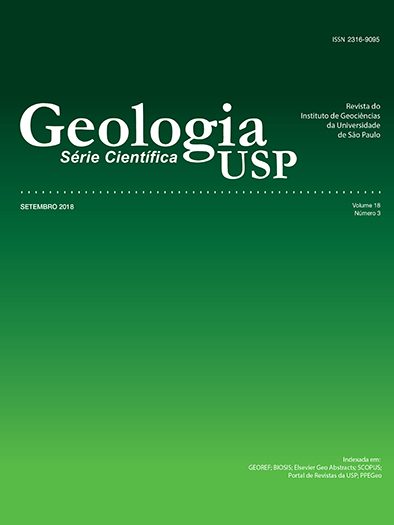Geochemical and gamma-spectrometry data on the evaluation of the potential of brasiliano igneous bodies to generate for rare earth elements ion adsorption clay concentration (Apiai-Guaxupé Terrain, Minas Gerais and São Paulo states, Brazil)
DOI:
https://doi.org/10.11606/issn.2316-9095.v18-140459Keywords:
Rare earth elements, Weathering, Exogenous concentration, Granitoids, AdsorptionAbstract
The rare earth elements are of increasing importance in the world economy, mainly due to their applications in the technology industry, which leads to the interest in prospecting mineral sources for these elements. In this context, a particular model of mineralization known in China stands out as the main source of heavy rare earth elements (Eu to Lu) and yttrium (Y), less common than light rare earth elements (La to Sm). This deposit type, called ion adsorption clay, consists of weathering profiles developed from biotite and/or muscovite granites, where the exogenous concentration of rare earth elements is given by the adsorption of these elements by neoformed kaolinitic clays by the weathering process. Several characteristics affect the genesis of these mineralizations, where the presence of rare earth elements minerals very susceptible to weathering and developmental characteristics of the exogenous alteration are of great importance for this type of rare earth elements enrichment. The Apiaí-Guaxupe Terrain, with a diversity of igneous bodies and Cenozoic weathering process, is an example of area with prospective potential to this deposit type. There are no descriptive information about rare earth elements (fluor)carbonate minerals, very susceptible to weathering and primordial to the genesis of these deposits, in these igneous bodies. Thus, the use of chemical informations and descriptions over accessory minerals and hydrothermal alteration to define the possibility of rare earth elements formation is necessary. In this work, the investigation of the potential enrichment of ion adsorption clay-type rare earth elements for this terrain was based on the use of published information of 16 syn-, tardi- and post-orogenic, Brasiliano igneous bodies,encompassing geologic, chemical (228 samples) and mineralogical
Downloads
Published
Issue
Section
License
Authors who publish in this journal shall comply with the following terms:
- Authors keep their copyright and grant to Geologia USP: Série Científica the right of first publication, with the paper under the Creative Commons BY-NC-SA license (summary of the license: https://creativecommons.org/licenses/by-nc-sa/4.0 | full text of the license: https://creativecommons.org/licenses/by-nc-sa/4.0/legalcode) that allows the non-commercial sharing of the paper and granting the proper copyrights of the first publication in this journal.
- Authors are authorized to take additional contracts separately, for non-exclusive distribution of the version of the paper published in this journal (publish in institutional repository or as a book chapter), granting the proper copyrights of first publication in this journal.
- Authors are allowed and encouraged to publish and distribute their paper online (in institutional repositories or their personal page) at any point before or during the editorial process, since this can generate productive changes as well as increase the impact and citation of the published paper (See The effect of Open Access and downloads on citation impact).





